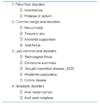Epidemiology of Diseases of the Colo-rectum and Anus
Article information
Abstract
The incidence of colorectal disease in Korea has been increasing along with the westernitation of the lifestyle. More hemorrhoidectomy and anal surgery have been done than ever. Dynamic graciloplasty, artificial bowel sphincter, and sacral nerve stimulation are done to manage anal incontinence. Constipation and irritable bowel syndrome are popular these days. However, there are few effective definite treatments for them. Ulcerative colitis develops in older age groups than in western countries, but Crohn's disease occurs in the same ages as in western countries. The prevalence of inflammatory bowel disease in Korea was 1/10 in ulcerative colitis and 1/20 in Crohn's disease, compared with North America, however, it increases rapidly. The incidence of colorectal cancer was 25.2 per 100,000 in male and 15.9 in female. The relative frequency of colorectal cancer is 10.5% of all sites, and colorectum is the 4th frequent site of cancers following stomach, lung, and liver. The five-year suvival rate of colorectal cancer in Korea was 49.4%. The management of anorectal disease should be based on medical evidence.



